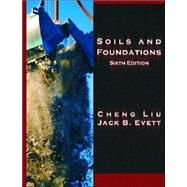
Note: Supplemental materials are not guaranteed with Rental or Used book purchases.
Purchase Benefits
What is included with this book?
| Preface | ix | ||||
| 1 Formation of Natural Soil Deposits | 1 | (8) | |||
|
1 | (1) | |||
|
1 | (2) | |||
|
3 | (1) | |||
|
4 | (5) | |||
| 2 Engineering Properties of Soils | 9 | (36) | |||
|
9 | (1) | |||
|
10 | (9) | |||
|
19 | (11) | |||
|
30 | (1) | |||
|
30 | (8) | |||
|
38 | (1) | |||
|
39 | (1) | |||
|
40 | (1) | |||
|
41 | (1) | |||
|
42 | (3) | |||
| 3 Soil Exploration | 45 | (38) | |||
|
45 | (1) | |||
|
45 | (1) | |||
|
46 | (10) | |||
|
56 | (1) | |||
|
56 | (6) | |||
|
62 | (6) | |||
|
68 | (2) | |||
|
70 | (8) | |||
|
78 | (2) | |||
|
80 | (1) | |||
|
80 | (3) | |||
| 4 Soil Compaction and Stabilization | 83 | (30) | |||
|
83 | (1) | |||
|
84 | (4) | |||
|
88 | (4) | |||
|
92 | (3) | |||
|
95 | (3) | |||
|
98 | (7) | |||
|
105 | (3) | |||
|
108 | (3) | |||
|
111 | (2) | |||
| 5 Water in Soil | 113 | (30) | |||
|
113 | (1) | |||
|
113 | (16) | |||
|
129 | (3) | |||
|
132 | (1) | |||
|
132 | (6) | |||
|
138 | (5) | |||
| 6 Stress Distribution in Soil | 143 | (28) | |||
|
143 | (1) | |||
|
143 | (5) | |||
|
148 | (20) | |||
|
168 | (3) | |||
| 7 Consolidation of Soil and Settlement of Structures | 171 | (56) | |||
|
171 | (2) | |||
|
173 | (2) | |||
|
175 | (10) | |||
|
185 | (3) | |||
|
188 | (1) | |||
|
189 | (4) | |||
|
193 | (17) | |||
|
210 | (4) | |||
|
214 | (8) | |||
|
222 | (5) | |||
| 8 Shear Strength of Soil | 227 | (30) | |||
|
227 | (1) | |||
|
228 | (14) | |||
|
242 | (6) | |||
|
248 | (1) | |||
|
248 | (7) | |||
|
255 | (2) | |||
| 9 Shallow Foundations | 257 | (54) | |||
|
257 | (1) | |||
|
258 | (3) | |||
|
261 | (3) | |||
|
264 | (24) | |||
|
288 | (5) | |||
|
293 | (12) | |||
|
305 | (1) | |||
|
305 | (1) | |||
|
306 | (5) | |||
| 10 Pile Foundations | 311 | (54) | |||
|
311 | (1) | |||
|
311 | (2) | |||
|
313 | (1) | |||
|
313 | (17) | |||
|
330 | (4) | |||
|
334 | (5) | |||
|
339 | (1) | |||
|
339 | (1) | |||
|
339 | (7) | |||
|
346 | (3) | |||
|
349 | (4) | |||
|
353 | (4) | |||
|
357 | (8) | |||
| 11 Drilled Shaft Foundations | 365 | (10) | |||
|
365 | (1) | |||
|
366 | (5) | |||
|
371 | (1) | |||
|
372 | (1) | |||
|
373 | (2) | |||
| 12 Lateral Earth Pressure | 375 | (38) | |||
|
375 | (1) | |||
|
376 | (7) | |||
|
383 | (7) | |||
|
390 | (6) | |||
|
396 | (2) | |||
|
398 | (6) | |||
|
404 | (2) | |||
|
406 | (4) | |||
|
410 | (3) | |||
| 13 Retaining Structures | 413 | (32) | |||
|
413 | (1) | |||
|
413 | (2) | |||
|
415 | (1) | |||
|
415 | (12) | |||
|
427 | (2) | |||
|
429 | (1) | |||
|
429 | (5) | |||
|
434 | (1) | |||
|
435 | (6) | |||
|
441 | (4) | |||
| 14 Stability Analysis of Slopes | 445 | (28) | |||
|
445 | (1) | |||
|
445 | (4) | |||
|
449 | (1) | |||
|
449 | (14) | |||
|
463 | (7) | |||
|
470 | (3) | |||
| Answers to Selected Problems | 473 | (2) | |||
| Appendix: Conversion Factors | 475 | (2) | |||
| References Cited | 477 | (4) | |||
| Index | 481 |
The New copy of this book will include any supplemental materials advertised. Please check the title of the book to determine if it should include any access cards, study guides, lab manuals, CDs, etc.
The Used, Rental and eBook copies of this book are not guaranteed to include any supplemental materials. Typically, only the book itself is included. This is true even if the title states it includes any access cards, study guides, lab manuals, CDs, etc.